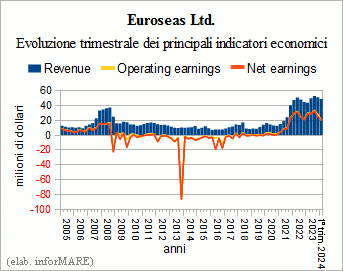
Euroseas, the company that owns a fleet of 22
container ships for hire, closed the first quarter
in 2024 with revenues of $48.3 million, with a
increase of +11.1% over the same period last year.
Operating profit amounted to €20.4 million, with a
decrease of -31.3% on the first quarter of 2023 which had
benefited, among other things, from income of €5.2 million from
from the sale of the
ship Akinada Bridge. Net profit is
$20.0 million (-30.4%).
 Commenting on the results recorded in the first three months of the
This year, the Chairman and CEO of Euroseas,
Aristides Pittas, explained that "during 2024 and until the
mid-May 2024
continued to recover, mainly in the wake of the greater
demand for ships driven by longer trade routes.
The latter condition was the case when the
have decided to avoid crossing the Red Sea and the
Suez Canal in reaction to attacks on ships in the area.
Since the beginning of the year, Pittas pointed out, ship rates have been
similar to our new 2,800 TEU builds have increased by
about 80%. Similar tariff increases have been recorded
in most segments. We took advantage of the
improvement of the tariff environment and we have concluded leases for
two of our new builds and we have extended the
some of our other vessels, generally at rates higher than
levels predicted three months ago. Although it's not clear for
how long will the tense situation in the Sea continue?
Red, after which rates could normalize, so far
Since the beginning of this year, the market has been able to
absorb the high level of new construction deliveries
determined by the substantial overall order book of vessels.
The orderbook, he added, is still high compared to the
historical standards, but has dropped to about 22% as a percentage
of the global fleet. For feeder and intermediate segments - ha
specified the manager of Euroseas, who is respectively 15 and
Seven ships of the two types in its fleet - The portfolio
orders is quite low and stands at around 8% of the total number of orders.
percentage of the global feeder fleet. In addition, more than 20% of the
Capacity of the feeder segment is over 20 years old
years. It is therefore not at all improbable," Pittas concluded
that the feeder fleet may even decrease in the coming years."
Commenting on the results recorded in the first three months of the
This year, the Chairman and CEO of Euroseas,
Aristides Pittas, explained that "during 2024 and until the
mid-May 2024
continued to recover, mainly in the wake of the greater
demand for ships driven by longer trade routes.
The latter condition was the case when the
have decided to avoid crossing the Red Sea and the
Suez Canal in reaction to attacks on ships in the area.
Since the beginning of the year, Pittas pointed out, ship rates have been
similar to our new 2,800 TEU builds have increased by
about 80%. Similar tariff increases have been recorded
in most segments. We took advantage of the
improvement of the tariff environment and we have concluded leases for
two of our new builds and we have extended the
some of our other vessels, generally at rates higher than
levels predicted three months ago. Although it's not clear for
how long will the tense situation in the Sea continue?
Red, after which rates could normalize, so far
Since the beginning of this year, the market has been able to
absorb the high level of new construction deliveries
determined by the substantial overall order book of vessels.
The orderbook, he added, is still high compared to the
historical standards, but has dropped to about 22% as a percentage
of the global fleet. For feeder and intermediate segments - ha
specified the manager of Euroseas, who is respectively 15 and
Seven ships of the two types in its fleet - The portfolio
orders is quite low and stands at around 8% of the total number of orders.
percentage of the global feeder fleet. In addition, more than 20% of the
Capacity of the feeder segment is over 20 years old
years. It is therefore not at all improbable," Pittas concluded
that the feeder fleet may even decrease in the coming years."